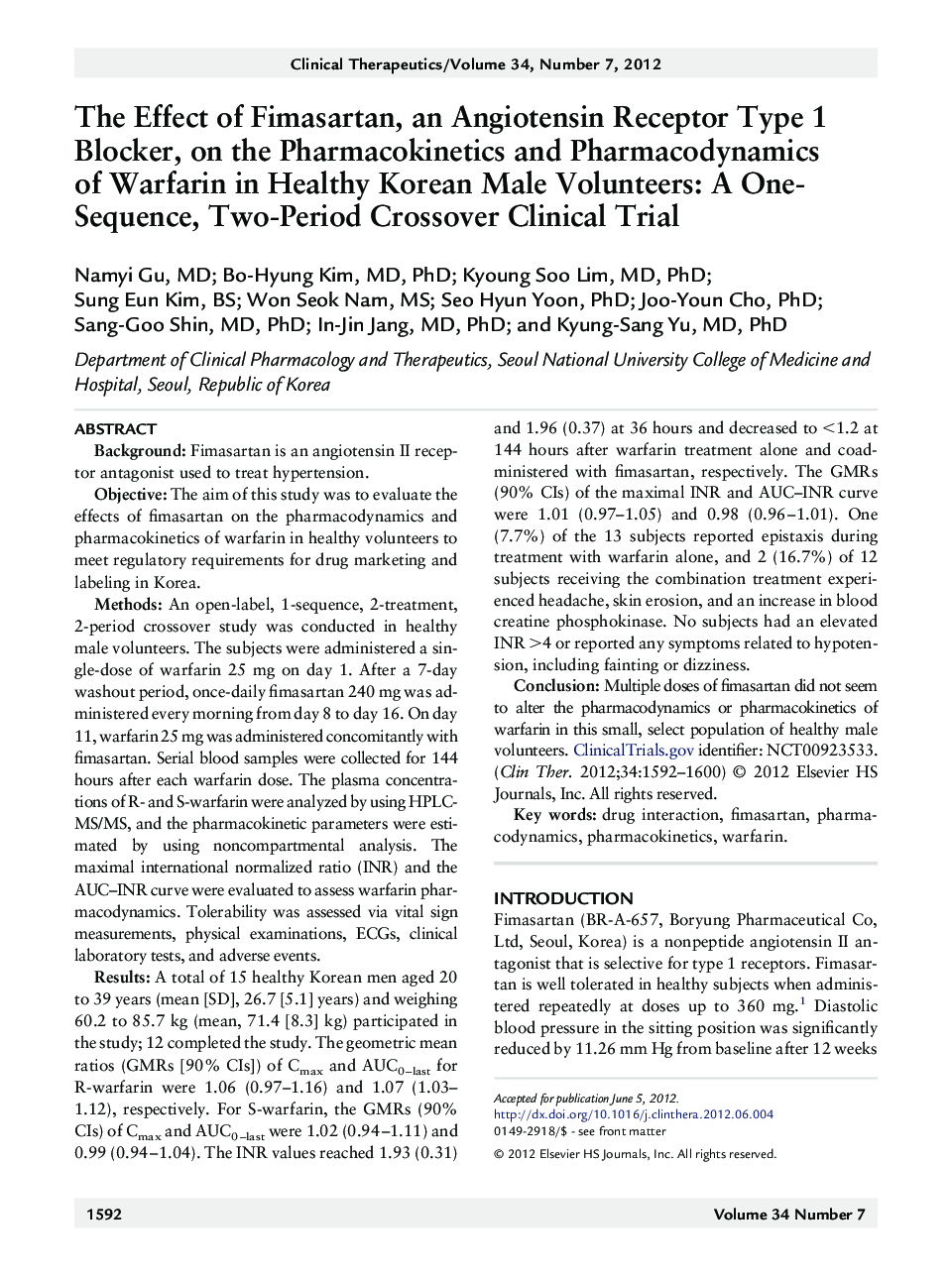| کد مقاله | کد نشریه | سال انتشار | مقاله انگلیسی | نسخه تمام متن |
|---|---|---|---|---|
| 2527168 | 1119901 | 2012 | 9 صفحه PDF | دانلود رایگان |

BackgroundFimasartan is an angiotensin II receptor antagonist used to treat hypertension.ObjectiveThe aim of this study was to evaluate the effects of fimasartan on the pharmacodynamics and pharmacokinetics of warfarin in healthy volunteers to meet regulatory requirements for drug marketing and labeling in Korea.MethodsAn open-label, 1-sequence, 2-treatment, 2-period crossover study was conducted in healthy male volunteers. The subjects were administered a single-dose of warfarin 25 mg on day 1. After a 7-day washout period, once-daily fimasartan 240 mg was administered every morning from day 8 to day 16. On day 11, warfarin 25 mg was administered concomitantly with fimasartan. Serial blood samples were collected for 144 hours after each warfarin dose. The plasma concentrations of R- and S-warfarin were analyzed by using HPLC-MS/MS, and the pharmacokinetic parameters were estimated by using noncompartmental analysis. The maximal international normalized ratio (INR) and the AUC–INR curve were evaluated to assess warfarin pharmacodynamics. Tolerability was assessed via vital sign measurements, physical examinations, ECGs, clinical laboratory tests, and adverse events.ResultsA total of 15 healthy Korean men aged 20 to 39 years (mean [SD], 26.7 [5.1] years) and weighing 60.2 to 85.7 kg (mean, 71.4 [8.3] kg) participated in the study; 12 completed the study. The geometric mean ratios (GMRs [90% CIs]) of Cmax and AUC0–last for R-warfarin were 1.06 (0.97–1.16) and 1.07 (1.03–1.12), respectively. For S-warfarin, the GMRs (90% CIs) of Cmax and AUC0–last were 1.02 (0.94–1.11) and 0.99 (0.94–1.04). The INR values reached 1.93 (0.31) and 1.96 (0.37) at 36 hours and decreased to <1.2 at 144 hours after warfarin treatment alone and coadministered with fimasartan, respectively. The GMRs (90% CIs) of the maximal INR and AUC–INR curve were 1.01 (0.97–1.05) and 0.98 (0.96–1.01). One (7.7%) of the 13 subjects reported epistaxis during treatment with warfarin alone, and 2 (16.7%) of 12 subjects receiving the combination treatment experienced headache, skin erosion, and an increase in blood creatine phosphokinase. No subjects had an elevated INR >4 or reported any symptoms related to hypotension, including fainting or dizziness.ConclusionMultiple doses of fimasartan did not seem to alter the pharmacodynamics or pharmacokinetics of warfarin in this small, select population of healthy male volunteers. ClinicalTrials.gov identifier: NCT00923533.
Journal: Clinical Therapeutics - Volume 34, Issue 7, July 2012, Pages 1592–1600